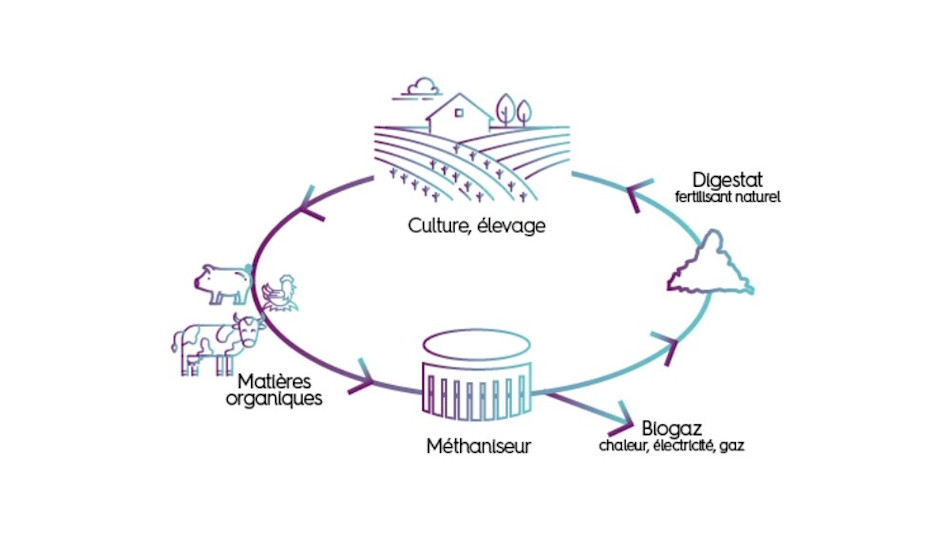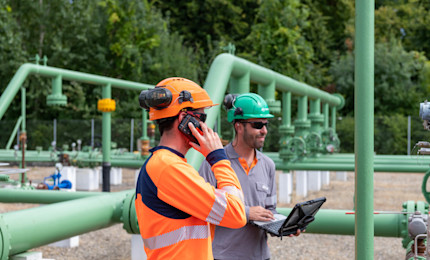Gas emergency 0 800 028 800

Teréga: an actor in the biomethane industry and energy transition
Because we want to affirm our role as an accelerator of energy transition, we play our part in the development of new gases, also known as “green gases”. That is the case with biomethane, which comes from the recovery of energy from organic household, agricultural and food industry waste. We help biomethane project promoters connect to our grid so they can develop this renewable energy source which helps reduce greenhouse gas (GHG) emissions.
How does biomethane contribute to a low-carbon energy mix?
As a responsible and committed gas actor, our ambition is clear: to decarbonise the energy system and reduce our environmental footprint. Our response to that target, which is both ambitious and essential, will be through the construction of a low-carbon, renewable, diversified, decentralised and efficient energy mix. Starting today.
To that end, biomethane offers a number of advantages:
it enables farmers, industry and local authorities to give their waste a second lease of life;
if turns them into actors in an industry which contributes to the development of a virtuous circular economy;
it is a 100% renewable energy source that can be injected into gas grids without requiring modifications to natural gas installations;
it satisfies the desire and need to reduce GHGs;
it encourages the economic development of the regions;
it offers a range of possible uses (in particular, its transformation into vehicular fuel, electricity or heat).
An industry that goes hand in hand with the circular economy

Biomethane: what is it, and where does it come from?
Biomethane starts with biogas: a product of the fermentation of plant or animal organic matter. That break-down can happen either naturally in the environment or artificially in digestors through an anaerobic digestion process (without oxygen): methanisation. The untreated biogas comprises 60% methane and 40% CO2.
Biomethane is then obtained from purified biogas to make it acceptable for injection into the natural gas grid. This phase is particularly important for removing CO2 and other undesirable compounds, resulting in a composition which is close to that of natural gas. Three stages are needed to reach that point:
decarbonisation, to remove CO2;
desulphurisation, to remove hydrogen sulphide;
dehydration, to remove water.
In this way, methanisation has many advantages:
two-fold exploitation of the organic matter and energy;
a reduction in the quantity of organic waste requiring treatment in other sectors;
a reduction in GHGs;
a reduction in the use of chemical fertilisers;
possible processing of oily or very wet non-compostable organic waste;
limited emission of noxious smells through the use of a hermetically sealed digestor.
At that point, the biomethane can be injected into gas grids and fulfil the same uses as natural gas, or alternatively be used as a fuel for vehicles (BioNGV).
Biomethane development: a long-standing commitment at teréga
Development of the biomethane sector involves a change in the way grids are operated. It is our role as a responsible actor to contribute to that change. Especially since the process involves both sustainable regional development and the long-term establishment of a new renewable gas sector. As a result, Teréga’s commitment to the biomethane sector can be seen in:
involvement in work groups at a national level,
support for the Occitanie, Nouvelle-Aquitaine and Auvergne-Rhône-Alpes regions as they develop their regional plans for land use, sustainable development and territorial equality (Schémas Régionaux d’Aménagement, de Développement Durable et d’Égalité des Territoires, or SRADDET) and territorial climate-air-energy plans (Plans Climat-Air-Énergie, or PCAET) as part of an interconnected communities approach, to encourage the “greening” of gas to benefit the regions,
management of the register of injection capacities in our area,
involvement in European moves on the issue through GIE and ENTSOG,
development of our research and innovation programme linked to the deployment of the sector,
support for the early stages of methanisation unit creation projects, through feasibility and viability studies.
![[object Object]](http://images.ctfassets.net/ztehsn2qe34u/5mYNs6qk98GPhhDy1lpcZB/72c1a291c9f4aeac3e9023108dec042d/intrants-substrats-stockage-biomethane-methanisation-nouveaux-gaz-methalayou.jpg)
Our aim is to maximise the volumes of renewable gases being injected, while guaranteeing security of supply. We build on our strengths to encourage the take-off of the biomethane sector in France:
our significant injection capacities as a transporter, with connection to storage;
the nature of our grid, in a rural setting, which favours local green gas production;
connections for all types of projects, both agricultural and/or industrial.
In 2015, we turned biomethane into a reality, bringing about the first injection into our grid. In 2017, we passed another milestone, allowing the injection of biomethane from methanisation into our underground storage facilities. Since then we have supported the creation of a number of methanisation unit projects, which are already or soon to be connected to our grid.
A few examples:
BioVilleneuvois
Our first biomethane project at Villeneuve sur Lot is also the largest French unit in Lot-et-Garonne. This methaniser is operated by Fonroche.
It represents €14m of investment over 4 years of development.
It entered service in 2015.
It injects around 500 Nm³/h into the Teréga grid, representing the consumption of 11,000 households.
Méthalayou
This biomethane project originated in the farming world, in Préchacq-Navarrenx, in the Pyrénées Atlantiques. 15 farmers set up a company so they could pool their waste.
It is the first methanisation site open to public subscription.
It entered service in July 2018.
It injects 100 Nm³/h into the Teréga grid, representing the consumption of 800 households.
Mélusine Énergie
This 100% agricultural methanisation unit is currently being built in Aillas, in the Gironde department. It will produce biomethane solely from input materials derived exclusively from farming activities. It will therefore enable livestock farming to continue in the area.
The site is scheduled to enter service by September 2021.
It will allow the injection of 230 Nm³/h.
SAS Agrienergie
This project, in Auros, is being driven by 9 farmers who want to diversify their businesses. The methanisation unit will be supplied with farm effluent (manure from cattle, sheep, poultry etc.), intermediate biofuel-producing crops, but also fruit and vegetable waste, along with grape pomace from a large wholesaler and a regional cooperative.
15,000 tonnes of biomass will be re-used in the production of biomethane equivalent to the consumption of 800 households.
The flow will be 100 Nm³/h but could go up to 120 Nm³/h.
It will enter service in 2022.
Teréga: innovation supporting the biomethane sector
Bolstered by these advances, we continue with our initiatives to encourage biomethane integration across our grid. Nothing must be left to chance, so our Research and Innovation teams are engaged in various projects to study future challenges and opportunities: anticipating safety issues, gas quality, flow management and continuity of supply.
Encouraging biomethane injection
One of our priorities is around our capacity to adapt our transport infrastructures and ensure they continue to operate safely in light of the developments associated with energy transition, and new gases in particular. Current scientific knowledge suggests that the composition of biomethane is very close to that of natural gas, and has no significant impact on our infrastructures. Nevertheless, we continue to be proactive on this issue and continue our efforts to improve our knowledge on the composition of all types of biomethane. In particular, we are working jointly with other European gas operators to provide a common vision and contribute to the standardisation of practices and gas quality.
DualMetha: an innovative methanisation process
Since June 2020 we have acquired a 20% holding in a French energy start-up, DualMetha, in collaboration with the Spanish natural gas storage and transport operator, Enagas (also acquiring a 20% holding). The aim is to play our part in the biomethane sector development strategy. In fact, DualMetha is proposing an innovative and ground-breaking methanisation process based on the combination of discontinuous solid digestion tanks and a continuous liquid digestion tank. This process is also supported by the French Environment and Energy Management Agency, ADEME. What sets it apart is the fact that the solid matter is immersed, which simplifies operation of the methanisation unit as much as possible. In fact, the matter does not require any preparation before being introduced into the digestion tanks, and even if it contains undesirable material, that has no effect on the process. This represents considerable time, money and energy savings.








